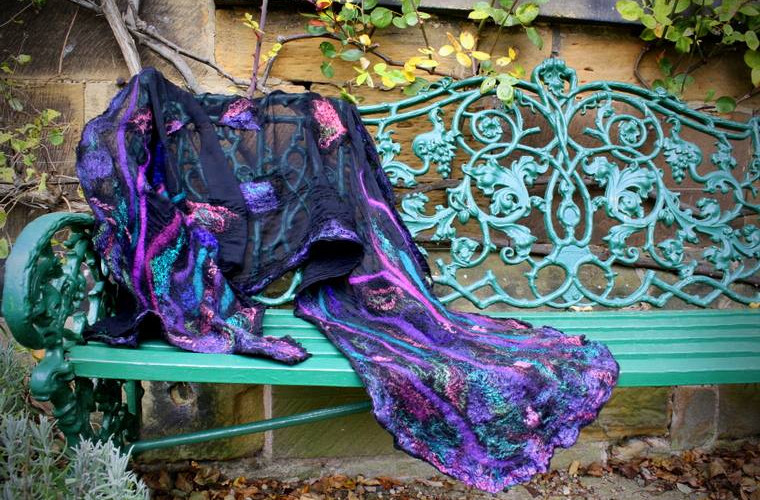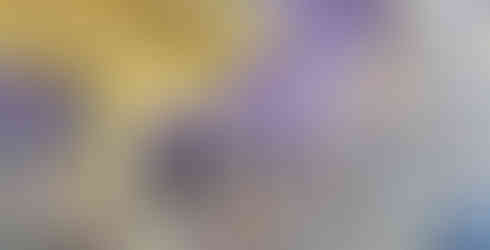Nuno Felting Tips: Fabrics suitable for nuno felt
- Lena Archbold

- Apr 12, 2024
- 4 min read
Updated: Apr 26, 2024
Exploring Fabrics Perfect for Nuno Felting
Nuno felting is a technique where loose fibers are fused onto a fabric base, resulting in lightweight yet sturdy textiles. This method has become increasingly popular for its versatility and beautiful outcomes. One of the key factors in successful nuno felting is choosing the right fabric. The choice of fabric significantly influences the final texture, drape, and overall quality of the finished piece. In this blog post, we'll explore some fabrics best suited for nuno felting projects.
1. Silk Chiffon
Silk chiffon is a favored option for nuno felting because of its delicate texture and lightweight feel. Its fine weave allows fibers to easily penetrate and bond, creating a smooth and flexible fabric with a luxurious touch. Silk chiffon drapes elegantly, making it perfect for crafting flowing garments and accessories. It's important to note that chiffon shrinks when wet, and it may not provide a high shine when felted. Chiffon comes in thicknesses of 3 and 5 mm. Beginners should ensure they purchase pure silk chiffon rather than polyester chiffon.
2. Silk Habotai
Also referred to as China silk, silk habotai is another fantastic choice for nuno felting projects. It is a heavier weight compared to chiffon, which lends more structure and stability to the final piece. With its smooth surface, silk habotai readily accepts fibres, allowing for the creation of intricate designs and vibrant color combinations. It's available in various thicknesses, such as Silk Ponge 5 and 6 mm, Silk Habotai 8, 10, and 12 mm. Thicker silk results in more texture. Margilan Excelsior is a silk similar to Ponge 5 but offers a more luxurious feel. These fabrics can be dyed using acid dyes to achieve vibrant colors and are excellent for botanical printing.
3. Cotton Gauze
For those looking for a more budget-friendly and easily accessible option, cotton gauze serves as an excellent alternative to silk fabrics in nuno felting projects. While it may lack the luxurious feel of silk, cotton gauze provides a soft and breathable foundation for felting endeavors. It's versatile, allowing for the creation of textures or serving as a base for felt laminating. Medical-grade cotton gauze stands out as the most economical option. Personally, I use cotton gauze for adding textures and as a backing for wall hangings. It's also handy in layering between wool to strengthen the felt, such as in felted bags.
4. Margilan Silk
In my practice, I often utilize Margilan rarefied silk for laminating felt. It's a favored choice due to its unique qualities.
Margilan Gauze Silk can also serve for felt lamination, although it tends to obscure the colors of the wool and produces light textures. It's particularly well-suited for garments and scarves.
Margilan Excelsior bears similarities to Ponge silk. However, in my experience, Excelsior is notably easier to felt.
To learn more about Margilan Silk, please check my blog, Margilan silk.
5. Synthetic Fabrics
I recommend working with synthetic fabrics for experienced feltmakers. Synthetic fabrics can yield beautiful textures, although not all are suitable for nuno felting. Fabrics with a very high shine should be avoided, as felting them can be time-consuming and challenging. Personally, I've found it's best to steer clear of such fabrics to save time and frustration.
I share how I work with synthetic fabrics in two of my online pre-recorded classes:
Nuno felting holds a special place in my heart, as I've been honing my skills in this technique for over 13 years. If you're eager to delve into the world of nuno felting or expand your existing knowledge, I invite you to explore my collection of online pre-recorded classes.
In these classes, I share my passion for nuno felting and provide step-by-step guidance to help you master this beautiful art form. Whether you're a beginner or a seasoned feltmaker, there's something for everyone to learn and enjoy.
Experiment and Break Boundaries
One of the joys of nuno felting is the opportunity to experiment and push the boundaries of traditional techniques. I encourage you to explore different fabrics beyond the usual suspects.
For instance, I've personally ventured into felting hessian and wool tweed fabrics, pushing the boundaries of what's possible in nuno felting. When working with thicker or stubborn fabrics, don't hesitate to try using a sander to aid the felting process. Check my blog on how to use sander in feltmaking.
Witness the Results
In my classes, I showcase the results of many experiments, demonstrating the unique textures and effects that can be achieved by incorporating unconventional fabrics into your nuno felting projects. You'll have the chance to witness the transformation of natural and synthetic fabrics into stunning felted creations, inspiring you to embark on your own creative journey.
If you missed my Facebook Live on fabrics suitable for nuno felt, then please check the video below.
Many thanks
Best wishes
Lena

.png)































































Comments